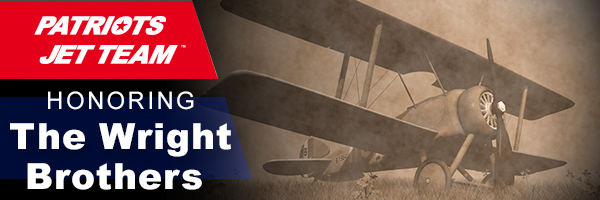
111 years ago, human flight became possible. On December 17, 1903*, it was an unfriendly, windswept day in Kitty Hawk, North Carolina. Chosen for its regular air currents and sandy banks for landing, Orville and Wilbur Wright were determined to make their flying machine a success.
At the time, the whole world was attempting to turn the dream of flight into a reality. Influential, well-funded men with illustrious educations were pumping tens of thousands of dollars into devising a powered, manned aircraft. It was the hottest pursuit of the moment.
The Wright Brothers, by contrast, never graduated from high school; they were the sons of a small town minister in Dayton Ohio. They started out in the newspaper trade where they designed and built their own printing presses, producing a weekly paper called the Westside News*. As bicycles gained more popularity, the Wrights decided to go into the bicycle business and it is because of this interim step that they stumbled upon some key elements to aircraft design.
Despite their lack of formal education, Orville and Wilbur were among the most accomplished engineers of their day. Wilbur had the mechanical skill and Orville had the vision to understand how all the moving parts came together. They realized that they could study aerodynamics on a micro scale by building a wind tunnel in the bike shop where they could rigorously record and analyze their data. It allowed their calculations to be much more exact and streamlined the testing process. These methods still inform modern engineering today.
The Wright team also made another crucial discovery: a technique they called “wing warping” that allows the wings to flex in order to keep the craft balanced, like a bicycle. Up until this point, turning and controlling the craft once it was in the air was a huge obstacle that had impeded the progress of many research teams, often resulting in fatal accidents. When they sprung on this principle, the Wrights knew they were onto something. In 1903, they took a new prototype to Kitty Hawk for testing.
And unlike we might imagine, there was no fan fair, no immediate media frenzy. When the lightweight, motorized craft with two propellers lifted off the ground on that windy beach, there were only a handful of people there to witness what would become one of the greatest accomplishments of the 20th century. When Orville successfully executed the first turn, he said he knew in his mind that they had just achieved the unimaginable.
However, it took five more years for the Wright Brothers to bring their motorized flying machine into the limelight. They applied for government funding and were denied. The obvious limitations of the craft made it a difficult sell: it could only carry one person and could only sustain small stints in the air. Wilbur traveled to France to try and convince investors that this craft was worthy of development. Negotiations failed.
After years of trying to promote the idea, the Wright Brothers received funding from President Theodore Roosevelt and the French government in 1908*. Suddenly, the whole world was paying attention. Wilbur traveled to France again to do demonstrations for aristocrats and heads of state from all over the globe.
Today, we hop on a plane without giving it a second thought. We travel at incredible speeds and send humans into space. None of this would have been possible without the tenacity and vision of these two brothers from Ohio. They were not driven by the lure of wealth or fame; they wanted to make a contribution to humanity.
In the modern era of aviation, the legacy of the Wright Brothers’ accomplishments are evident everywhere, not just in terms of technology and process but also the impact of their philosophy. It is with this same spirit that the Patriots Jet Team has energized crowds and unveiled the power of possibility to many young minds. On this anniversary of powered flight, we salute the tremendous will and inquisitiveness that allowed Wilbur and Orville Wright to soar so high.
References:
*. The birth of flight control: An engineering analysis of the Wright brothers’
1902 glider by Padfield and Lawrence see pdf.: http://pcwww.liv.ac.uk/eweb/fst/publications/2854.pdf
Main Reference: PBS documentary: The American Experience: The Wright Stuff: https://www.youtube.com/watch?v=XoFib7jWOLE
Note on this: on Youtube, this program is broken up into parts but all 6 parts are viewable on this link.

